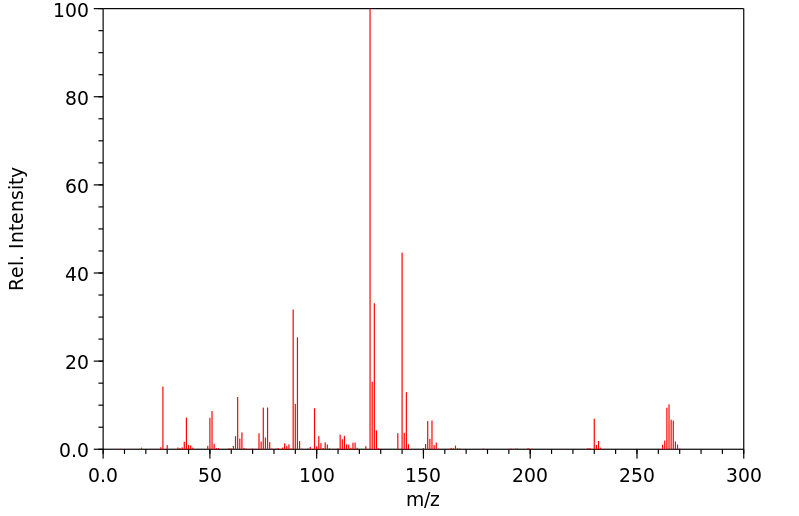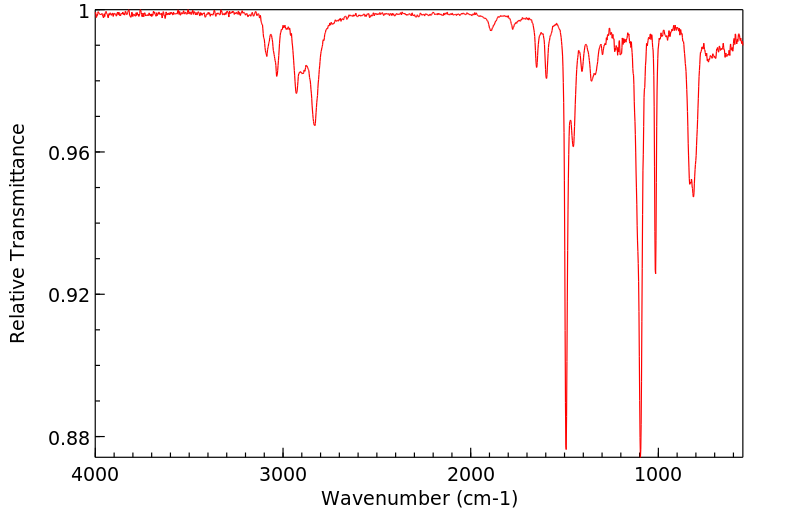N,N-二(4-氯苄基)羟胺 | 40861-08-3
中文名称
N,N-二(4-氯苄基)羟胺
中文别名
——
英文名称
N,N-bis(4-chlorobenzyl)hydroxylamine
英文别名
N,N-bis[(4-chlorophenyl)methyl]hydroxylamine
CAS
40861-08-3
化学式
C14H13Cl2NO
mdl
MFCD00051610
分子量
282.169
InChiKey
LJISSWQMTWDSGS-UHFFFAOYSA-N
BEILSTEIN
——
EINECS
——
-
物化性质
-
计算性质
-
ADMET
-
安全信息
-
SDS
-
制备方法与用途
-
上下游信息
-
文献信息
-
表征谱图
-
同类化合物
-
相关功能分类
-
相关结构分类
物化性质
-
沸点:434.1±40.0 °C(Predicted)
-
密度:1.333±0.06 g/cm3(Predicted)
计算性质
-
辛醇/水分配系数(LogP):4
-
重原子数:18
-
可旋转键数:4
-
环数:2.0
-
sp3杂化的碳原子比例:0.142
-
拓扑面积:23.5
-
氢给体数:1
-
氢受体数:2
安全信息
-
安全说明:S26,S36
-
危险类别码:R36/37/38
-
海关编码:2928000090
SDS
上下游信息
-
上游原料
中文名称 英文名称 CAS号 化学式 分子量 对氯苄胺 4-chlorobenzylamine 104-86-9 C7H8ClN 141.6
反应信息
-
作为反应物:描述:参考文献:名称:Mechanism of the 10-methylacridinium ion-sensitized photooxidation of N,N-dibenzylhydroxylamine and its derivatives in acetonitrile摘要:取代的 N,N-二苄基羟胺(1)在乙腈中的 10-甲基吖啶离子(MA+)敏化光氧化反应主要是通过超氧离子机制发生的,从而定量生成 N-亚苄基苄胺 N-氧化物(2)和过氧化氢。 分析取代基对生成 2 的极限量子产率的影响表明,从 10-甲基吖啶基(MA˙)到自由基阳离子 1+˙ 的反向电子转移(ET)是在马库斯 "正常区域 "进行的。此外,还发现这种反向 ET 比 MA˙对 O2 的单电子还原更优先发生。DOI:10.1039/b009206l
-
作为产物:描述:参考文献:名称:三重二苯甲酮活化的O-(1-萘甲酰基)-N,N-双(对位取代苄基)羟胺的亚胺形成自由基消除反应摘要:结果表明,尽管在标题羟胺 1 和二苯甲酮之间发生了扩散受限的三线态能量转移,但三线态 1 分解效率低下,得到对位取代的 N-(对位取代的亚苄基)苄胺 2 和 1-萘甲酸 (3) 作为单分子自由基消除产品。kr/kd 比率的对数(其中 kr 是三重态 1 中 N-O 键均裂的速率常数,kd 是其失活的速率常数)用作 1 的三重态反应性的度量,表明对取代基常数的依赖性可以忽略不计。这一发现被解释为离子结构对 N-O 键均裂的过渡态的贡献很小。DOI:10.1246/bcsj.72.2537
文献信息
-
Graphene oxide as a metal-free catalyst for oxidation of primary amines to nitriles by hypochlorite作者:Ana Primo、Marta Puche、Octavian D. Pavel、Bogdan Cojocaru、Alina Tirsoaga、Vasile Parvulescu、Hermenegildo GarcíaDOI:10.1039/c5cc09463a日期:——
Graphene oxide catalyzes NaClO oxidation of primary benzyl and aliphatic amines to a product distribution comprising nitriles and imines.
-
s-Tetrazine: Robust and Green Photoorganocatalyst for Aerobic Oxidation of N,N-Disubstituted Hydroxylamines to Nitrones作者:Géraldine Masson、Jiyuan Lyu、Tuan Le、Aurélie Claraz、Clémence Allain、Pierre AudebertDOI:10.1055/a-1691-0449日期:2022.1photocatalytic aerobic oxidative dehydrogenation reactions of N,N-disubstituted hydroxylamines to nitrones were developed with an in situ generated photocatalyst based on commercially available 3,6-dichlorotetrazine. This process affords a wide range of nitrones in high yields under mild conditions. In addition, an oxidative (3+3) cycloaddition between an oxyallyl cation precursor and a hydroxylamine was also developed
-
The Reactivity of Difluorocarbene with Hydroxylamines: Synthesis of Carbamoyl Fluorides作者:Hannah Baars、Julien Engel、Lucas Mertens、Daniela Meister、Carsten BolmDOI:10.1002/adsc.201600308日期:2016.7.14Carbamoyl fluorides are formed in reactions of hydroxylamines with difluorocarbene generated from sodium bromodifluoroacetate as readily available and non‐toxic carbene precursor. The process shows a high functional group tolerance, and the reaction path has been rationalized by computational calculations.
-
Kinetic and Mechanistic Study of the Pt(II) versus Pt(IV) Effect in the Platinum-Mediated Nitrile−Hydroxylamine Coupling作者:Konstantin V. Luzyanin、Vadim Yu. Kukushkin、Alexander D. Ryabov、Matti Haukka、Armando J. L. PombeiroDOI:10.1021/ic048388c日期:2005.4.1and trans-1; Et, cis-2 and trans-2; CH(2)Ph, cis-3 and trans-3; CH(2)C(6)H(4)Cl-p, cis-4 and trans-4; n = 4, R = Me, trans-9; Et, trans-10; CH(2)Ph, trans-11; CH(2)C(6)H(4)Cl-p, trans-12) or [Ph(3)PCH(2)Ph][PtCl(n)NH=C(Et)ONR(2)}] (n = 3, R = Me, 5; Et, 6; CH(2)Ph, 7; CH(2)C(6)H(4)Cl-p, 8; n = 5, R = Me, 13; Et, 14; CH(2)Ph, 15; CH(2)C(6)H(4)Cl-p, 16) in excellent to good (95-80%) isolated yields. The16)优良至优良(95-80%)的分离产率。Pt(IV)配合物9-16与叶立德Ph(3)P = CHCO(2)Me的还原可以合成Pt(II)物种1-8。通过元素分析(C,H,N),FAB-MS,IR,(1)H,(13)C (1)H}和(31)P (1)H } NMR(后者用于阴离子型络合物5-8和13-16),并通过X射线晶体学测定Pt(II)(顺式1,顺式2和反式4)和Pt(IV)( 15)种。向复合物[Ph(3)PCH(2)Ph] [Pt(II)Cl(3)添加R(2)NOH(R = CH(2)C(6)H(4)Cl-p)的动力学研究)(EtCN)]和[Ph(3)PCH(2)Ph] [Pt(IV)Cl(5)(EtCN)]通过(1)H NMR技术显示,两个反应都是(p-ClC (6)H(4)CH(2))(2)NOH和Pt(II)或Pt(IV)络合物,对于Pt(IV),二阶速率常数k(
-
The first example of Re(IV)-mediated nitrile–hydroxylamine coupling作者:Konstantin V. Luzyanin、Vadim Yu. Kukushkin、Matti Haukka、Armando J.L. PombeiroDOI:10.1016/j.inoche.2006.04.010日期:2006.7Abstract The metal-mediated coupling between the acetonitriles in cis-[ReIVCl4(MeCN)2] and the N,N-dibenzylhydroxylamines R 2 3 NOH (R3 = CH2Ph, CH2C6H4C1-p) proceeds smoothly in CH2Cl2/MeCN at 20–25 °C for ca. 15 min to accomplish new imino species cis - [ ReCl 4 NH C ( Me ) ONR 2 3 } 2 ] (R3 = CH2Ph, 1, CH2C6H4C1-p, 2) in ca. 70% yield. The structures of the isolated compounds were based on elemental
表征谱图
-
氢谱1HNMR
-
质谱MS
-
碳谱13CNMR
-
红外IR
-
拉曼Raman
-
峰位数据
-
峰位匹配
-
表征信息
同类化合物
(βS)-β-氨基-4-(4-羟基苯氧基)-3,5-二碘苯甲丙醇
(S,S)-邻甲苯基-DIPAMP
(S)-(-)-7'-〔4(S)-(苄基)恶唑-2-基]-7-二(3,5-二-叔丁基苯基)膦基-2,2',3,3'-四氢-1,1-螺二氢茚
(S)-盐酸沙丁胺醇
(S)-3-(叔丁基)-4-(2,6-二甲氧基苯基)-2,3-二氢苯并[d][1,3]氧磷杂环戊二烯
(S)-2,2'-双[双(3,5-三氟甲基苯基)膦基]-4,4',6,6'-四甲氧基联苯
(S)-1-[3,5-双(三氟甲基)苯基]-3-[1-(二甲基氨基)-3-甲基丁烷-2-基]硫脲
(R)富马酸托特罗定
(R)-(-)-盐酸尼古地平
(R)-(-)-4,12-双(二苯基膦基)[2.2]对环芳烷(1,5环辛二烯)铑(I)四氟硼酸盐
(R)-(+)-7-双(3,5-二叔丁基苯基)膦基7''-[((6-甲基吡啶-2-基甲基)氨基]-2,2'',3,3''-四氢-1,1''-螺双茚满
(R)-(+)-7-双(3,5-二叔丁基苯基)膦基7''-[(4-叔丁基吡啶-2-基甲基)氨基]-2,2'',3,3''-四氢-1,1''-螺双茚满
(R)-(+)-7-双(3,5-二叔丁基苯基)膦基7''-[(3-甲基吡啶-2-基甲基)氨基]-2,2'',3,3''-四氢-1,1''-螺双茚满
(R)-(+)-4,7-双(3,5-二-叔丁基苯基)膦基-7“-[(吡啶-2-基甲基)氨基]-2,2”,3,3'-四氢1,1'-螺二茚满
(R)-3-(叔丁基)-4-(2,6-二苯氧基苯基)-2,3-二氢苯并[d][1,3]氧杂磷杂环戊烯
(R)-2-[((二苯基膦基)甲基]吡咯烷
(R)-1-[3,5-双(三氟甲基)苯基]-3-[1-(二甲基氨基)-3-甲基丁烷-2-基]硫脲
(N-(4-甲氧基苯基)-N-甲基-3-(1-哌啶基)丙-2-烯酰胺)
(5-溴-2-羟基苯基)-4-氯苯甲酮
(5-溴-2-氯苯基)(4-羟基苯基)甲酮
(5-氧代-3-苯基-2,5-二氢-1,2,3,4-oxatriazol-3-鎓)
(4S,5R)-4-甲基-5-苯基-1,2,3-氧代噻唑烷-2,2-二氧化物-3-羧酸叔丁酯
(4S,4''S)-2,2''-亚环戊基双[4,5-二氢-4-(苯甲基)恶唑]
(4-溴苯基)-[2-氟-4-[6-[甲基(丙-2-烯基)氨基]己氧基]苯基]甲酮
(4-丁氧基苯甲基)三苯基溴化磷
(3aR,8aR)-(-)-4,4,8,8-四(3,5-二甲基苯基)四氢-2,2-二甲基-6-苯基-1,3-二氧戊环[4,5-e]二恶唑磷
(3aR,6aS)-5-氧代六氢环戊基[c]吡咯-2(1H)-羧酸酯
(2Z)-3-[[(4-氯苯基)氨基]-2-氰基丙烯酸乙酯
(2S,3S,5S)-5-(叔丁氧基甲酰氨基)-2-(N-5-噻唑基-甲氧羰基)氨基-1,6-二苯基-3-羟基己烷
(2S,2''S,3S,3''S)-3,3''-二叔丁基-4,4''-双(2,6-二甲氧基苯基)-2,2'',3,3''-四氢-2,2''-联苯并[d][1,3]氧杂磷杂戊环
(2S)-(-)-2-{[[[[3,5-双(氟代甲基)苯基]氨基]硫代甲基]氨基}-N-(二苯基甲基)-N,3,3-三甲基丁酰胺
(2S)-2-[[[[[((1S,2S)-2-氨基环己基]氨基]硫代甲基]氨基]-N-(二苯甲基)-N,3,3-三甲基丁酰胺
(2S)-2-[[[[[[((1R,2R)-2-氨基环己基]氨基]硫代甲基]氨基]-N-(二苯甲基)-N,3,3-三甲基丁酰胺
(2-硝基苯基)磷酸三酰胺
(2,6-二氯苯基)乙酰氯
(2,3-二甲氧基-5-甲基苯基)硼酸
(1S,2S,3S,5S)-5-叠氮基-3-(苯基甲氧基)-2-[(苯基甲氧基)甲基]环戊醇
(1S,2S,3R,5R)-2-(苄氧基)甲基-6-氧杂双环[3.1.0]己-3-醇
(1-(4-氟苯基)环丙基)甲胺盐酸盐
(1-(3-溴苯基)环丁基)甲胺盐酸盐
(1-(2-氯苯基)环丁基)甲胺盐酸盐
(1-(2-氟苯基)环丙基)甲胺盐酸盐
(1-(2,6-二氟苯基)环丙基)甲胺盐酸盐
(-)-去甲基西布曲明
龙蒿油
龙胆酸钠
龙胆酸叔丁酯
龙胆酸
龙胆紫-d6
龙胆紫








